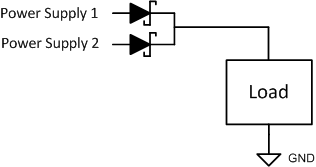SLVAE57B February 2021 – October 2021 LM5050-1 , LM5050-2 , LM5051 , LM66100 , LM74202-Q1 , LM74500-Q1 , LM74610-Q1 , LM74700-Q1 , LM74720-Q1 , LM74721-Q1 , LM74722-Q1 , LM7480-Q1 , LM7481-Q1 , LM76202-Q1 , SM74611 , TPS2410 , TPS2411 , TPS2412 , TPS2413 , TPS2419
- Trademarks
- 1 Introduction
- 2 Reverse Battery Protection
- 3 ORing Power Supplies
- 4 Reverse Battery Protection using MOSFETs
- 5 Reverse Polarity Protection vs Reverse Current Blocking
- 6 What is an Ideal Diode Controller?
- 7 Automotive Transient protection with Ideal Diode Controllers
- 8 ORing Power Supplies with Ideal Diode Controllers
- 9 Integrated Ideal Diode Solution
- 10Summary
- 11References
- 12Revision History
3 ORing Power Supplies
Schottky diodes are traditionally used to OR two or more power supplies to increase system redundancy or increase power capacity in N+1 configuration. Typically more than one power supply units (PSU) are paralleled using schottky diodes in a N+1 redundant configuration. Minimum 'N' supplies are required to power the load and additional supply unit is provided for redundancy in case of a single point failure: one power supply unit fails. Power supply with higher voltage provides most or all of the power required by the load. To share loads almost equally among the power supplies, power supply DC set point is adjusted to match other units closely.
 Figure 3-1 Diode ORing
Figure 3-1 Diode ORingFigure 3-1 shows dual ORing scheme where two PSUs power the load through two schottky diodes. When one of the power supply fails and its input is shorted, schottky diode in its path is reverse biased and isolates the other power supply from the failure. Load remains fully powered from the working power supply until the faulty unit is replaced.
Load Sharing: Load sharing between two power supplies is mainly dependent on the forward voltage difference of the schottky diodes and voltage difference between two power supplies. Power supply with higher voltage and lower forward voltage schottky diode carries most of the current. Forward voltage drop of the schottky diode has a negative temperature co-efficient and it reduces with increasing temperature. This can lead to situation where a single supply carries the entire load current though second supply is still present and results in increased junction temperature TJ. This necessitates a careful heat sink design and thermal management between two diodes.
Power Dissipation and Thermal Management: Apart from the key concerns such as power dissipation and the associated thermal management, reverse leakage current at a higher temperature can result in efficiency loss and lead to thermal run away situations if thermal design is not done properly. Reverse leakage current of high voltage schottky diodes increase drastically with temperature. For example, 60 V rated schottky diode STPS20M60S has a 100 mA reverse leakage current at 150 °C, which amounts to 6 W of power dissipation at -60 V. Consider a case when only one power supply is fully supplying the load current due to forward voltage difference of schottky diodes or offset in power supply DC set point. If this first power supply fails, the second supply takes over and supplies the entire load, but the schottky diode of the first one had a higher TJ before turning off and conducts large reverse leakage current. This can lead to a thermal run-away situation where the schottky continues to conduct increased reverse current and gets damaged. A damaged schottky diode and failed power supply can pull down the entire power system leading to a system failure. Even if thermal run-away is avoided by careful heat sink design, sustained power dissipation in the reverse conduction results in unwanted power loss.